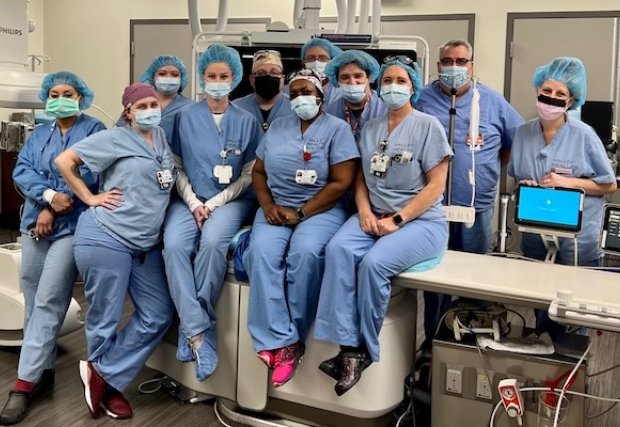New Procedure at Spring Valley Hospital Treats Patients with Blood Clots

Members of the Cardiac Catheterization team at Spring Valley Hospital.
Spring Valley Hospital now offers ClotTriever®, a recently acquired technology treatment for pulmonary embolisms (PE). ClotTriever is an FDA-cleared mechanical thrombectomy device created to treat people with PE.
“Pulmonary embolisms occur when blood clots break free and begin traveling through the body, such as the venous system, which carries blood from your heart to other organs, including the lungs,” said Leon Varjabedian, MD, interventional cardiologist with Heart Center of Nevada. “When this happens, a person needs to have their blood flow quickly and safely restored. If not, this could result in sudden death if the clot burden is large. It could also result in chronic oxygen dependency if not treated in time.”
For the procedure, patients undergo a one-time, approximately one-hour session under conscious sedation while the physician – either a specifically trained interventional cardiologist or radiologist – threads a catheter into a pulmonary artery to capture and remove the clot(s). The technology eliminates the need for clot-busting drugs, called thrombolytics, which often require time spent in the intensive care unit.
Cardiovascular Services in Southwest Las Vegas
Patient Success Story
Myngo Lee became one of the first patients at Spring Valley Hospital to benefit from ClotTriever. When Myngo and her husband decided to ring in 2022 in Las Vegas via a cross-country drive, neither of them imagined what the new year would hold.
“We arrived on December 28, pushing through the last two hours,” said Myngo. “I was going to check in to our timeshare, but I could barely stand because of a cramp in my left leg. I was having a hard time breathing, but I thought it was anxiety from the long drive and the Las Vegas traffic.”
Finally, Myngo’s husband insisted on a visit to a nearby urgent care – who promptly sent her to Spring Valley Hospital Medical Center.
What Myngo thought was anxiety turned out to be both lungs filled with “massive pulmonary embolisms,” she said. It may have been brewing for a long time and the lengthy drive triggered it. “It’s a blessing because I was in the best place if I was going to have that kind of condition,” she said.
After the ClotTriever procedure, Myngo said, “I had breathing issues before [the trip], but I feel way better than I have in a long time.” She remains closely monitored by multiple specialists regarding her health. Three months post-procedure, her outlook is both bright and grateful. “I knew it was serious, but until Roger [Swayze, Cardiovascular Services Director] came to check on me – everyone came to check on me – I didn’t understand the severity of it. He told me, ‘It’s amazing you’re not on a ventilator and you’re up walking.’ So now my question is, how do I thank someone for saving my life?”
This procedure is also available at Centennial Hills and Valley hospitals.
Fast Facts About Pulmonary Embolisms
What is a PE?
A PE is a sudden blockage in the lung artery that can be life threatening or cause permanent lung damage, low blood oxygen levels and damage to other organs. It is typically caused by a blood clot in the leg (deep vein thrombosis) that travels to the lung.
PE Risk Factors
Risk factors include having had joint replacement surgery; certain cancers; heart and lung diseases; pregnancy and childbirth; not moving for long periods of time (road or plane trips, bed rest, having a cast); hormone-based medicines; age (after 40); and family history.
Common Symptoms
- Shortness of breath
- Chest pain that may become worse when breathing in
- Cough, which may contain blood
- Leg pain or swelling
- Pain in your back
- Excessive sweating
- Lightheadedness, dizziness or passing out
- Blueish lips or nails
